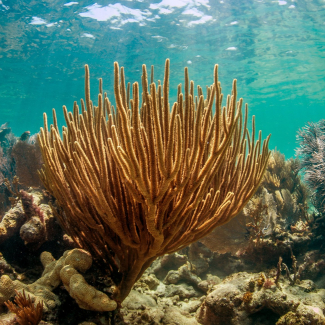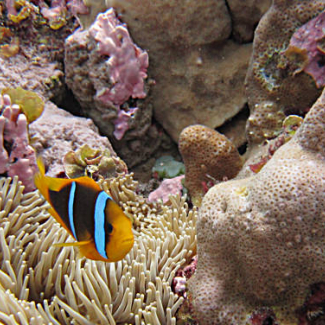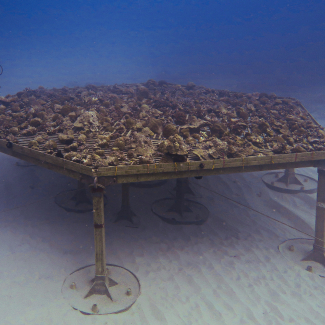What Kind Of Animals Live In The Coral Reef
Coral reef ecosystems
Coral reefs are some of the most diverse ecosystems in the world. Coral polyps, the animals primarily responsible for building reefs, tin take many forms: big reef edifice colonies, svelte flowing fans, and even small, solitary organisms. Thousands of species of corals accept been discovered; some alive in warm, shallow, tropical seas and others in the cold, dark depths of the ocean.
Coral reef diversity
Because of the diversity of life found in the habitats created past corals, reefs are often called the "rainforests of the sea." Nearly 25% of the sea's fish depend on healthy coral reefs. Fishes and other organisms shelter, find food, reproduce, and rear their young in the many nooks and crannies formed by corals. The Northwest Hawaiian Island coral reefs, which are part of the Papahānaumokuākea National Marine Monument, provide an instance of the diversity of life associated with shallow-water reef ecosystems. This expanse supports more than 7,000 species of fishes, invertebrates, plants, ocean turtles, birds, and marine mammals. Deep water reefs or mounds are less well known, but also support a wide array of ocean life in a insufficiently barren world.

By restoring corals at seven iconic reef sites in Florida Keys National Marine Sanctuary, we can modify the trajectory of an entire ecosystem and help save one of the world's virtually unique areas for future generations.
Coral characteristics
Shallow water, reef-building corals accept a symbiotic relationship with photosynthetic algae called zooxanthellae, which alive in their tissues. The coral provides a protected environs and the compounds zooxanthellae need for photosynthesis. In render, the algae produce carbohydrates that the coral uses for food, besides equally oxygen. The algae besides help the coral remove waste product. Since both partners do good from clan, this type of symbiosis is called mutualism.
Deep-sea corals alive in much deeper or colder oceanic waters and lack zooxanthellae. Unlike their shallow water relatives, which rely heavily on photosynthesis to produce food, deep sea corals take in plankton and organic matter for much of their energy needs.
Benefits of coral reef ecosystems
Coral reefs protect coastlines from storms and erosion, provide jobs for local communities, and offer opportunities for recreation. They are likewise are a source of food and new medicines. Over half a billion people depend on reefs for food, income, and protection. Fishing, diving, and snorkeling on and nearly reefs add hundreds of millions of dollars to local businesses. The cyberspace economical value of the world's coral reefs is estimated to be most tens of billions offsite link of U.Due south. dollars per twelvemonth. These ecosystems are culturally of import to ethnic people around the world.

Corals accept long been popular as souvenirs, for home decor, and in jewelry, merely many consumers are unaware that these beautiful structures are fabricated by living creatures. Fewer nonetheless realize that corals are dying off at alarming rates.
Threats to coral reef ecosystems
Unfortunately, coral reef ecosystems are severely threatened. Some threats are natural, such every bit diseases, predators, and storms. Other threats are caused past people, including pollution, sedimentation, unsustainable fishing practices, and climate alter, which is raising ocean temperatures and causing sea acidification. Many of these threats can stress corals, leading to coral bleaching and possible death, while others cause concrete harm to these delicate ecosystems. During the 2014-2017 coral bleaching outcome, unusually warm waters (partially associated with a strong El Niño) affected 70% of coral reef ecosystems worldwide. Some areas were hitting particularly hard, like the Great Barrier Reef in Australia, where hundreds of miles of coral were bleached.
Corals are able to recover from bleaching events if conditions meliorate before they die, though it tin take many years for the ecosystems to fully heal. Scientists are also testing new ways to aid coral reef ecosystems, such as growing coral in a nursery and then transplanting information technology to damaged areas.

The nursery could help restore damaged reefs using fully formed coral colonies rather than small-scale fragments.
Teaching CONNECTION
Educators can utilise the resources in this drove to teach students about the scientific discipline and beauty of corals. They can use these organisms and ecosystems to teach many scientific concepts including symbiotic relationships, reproduction strategies, nutrient webs, chemical science, biotic and abiotic interactions, human being impacts, and more. Additionally, educators can use corals to teach most conservation and stewardship of the environment. Even if you don't live near a reef, students can learn that they tin help protect coral reefs in the United States and effectually the world. There are many actions, small and large, that everyone can accept to help conserve coral reefs.
Source: https://www.noaa.gov/education/resource-collections/marine-life/coral-reef-ecosystems
Posted by: urbanekunked1956.blogspot.com

0 Response to "What Kind Of Animals Live In The Coral Reef"
Post a Comment